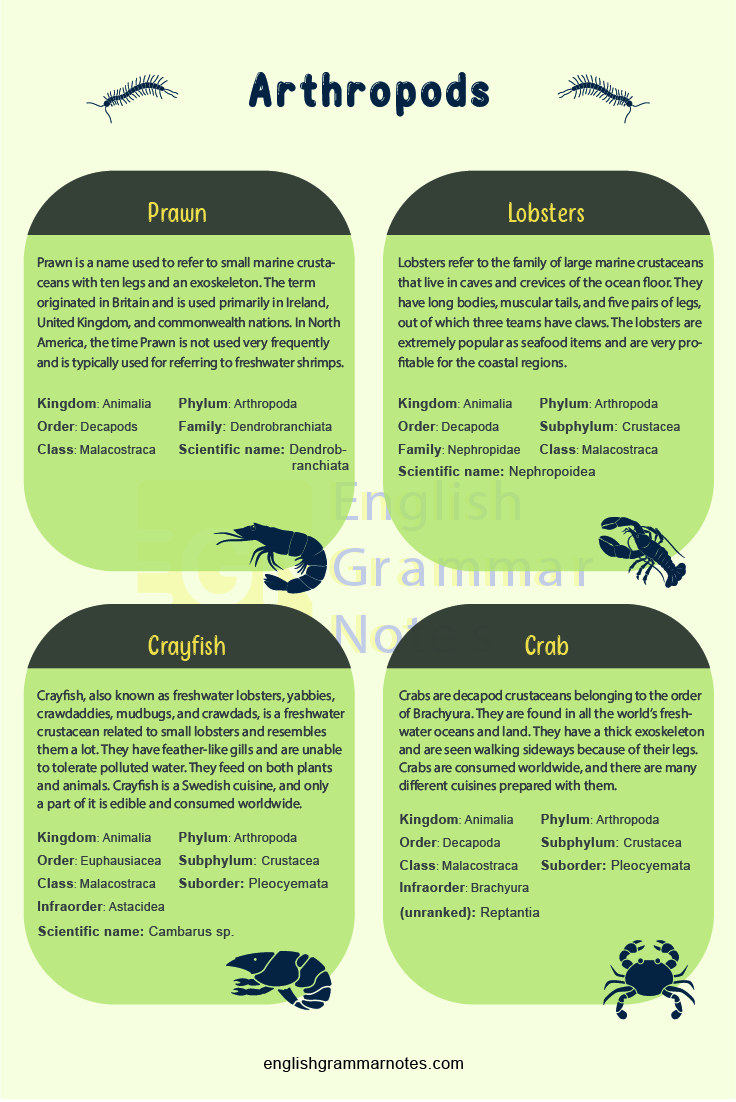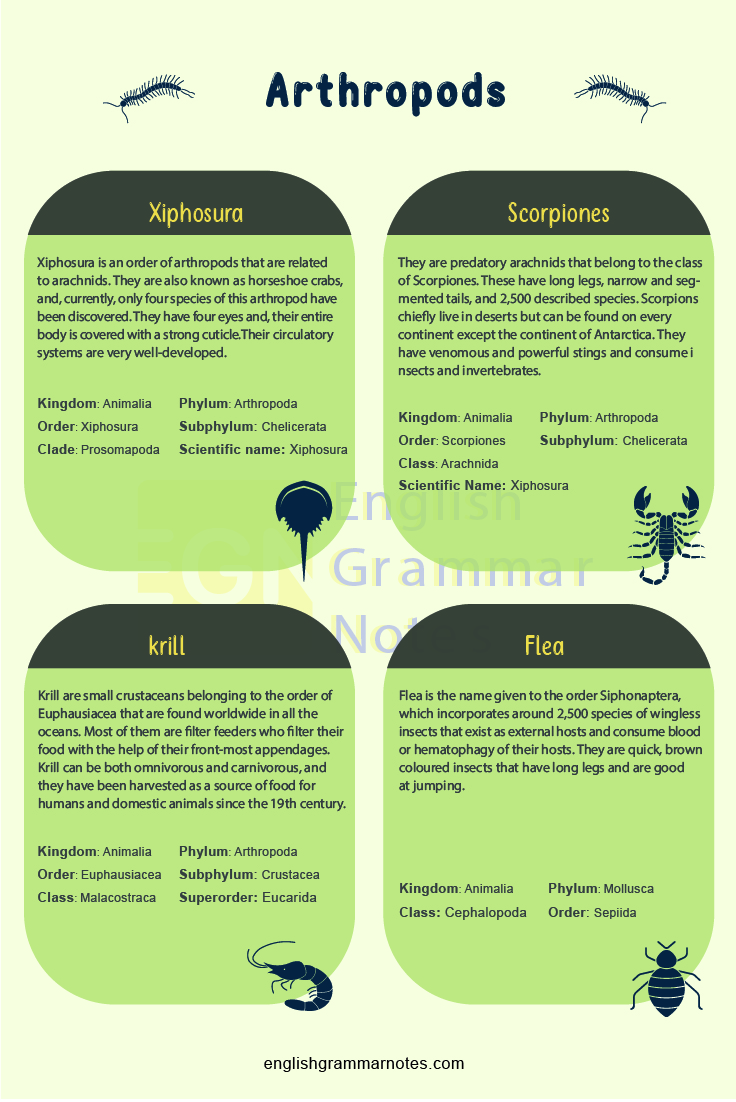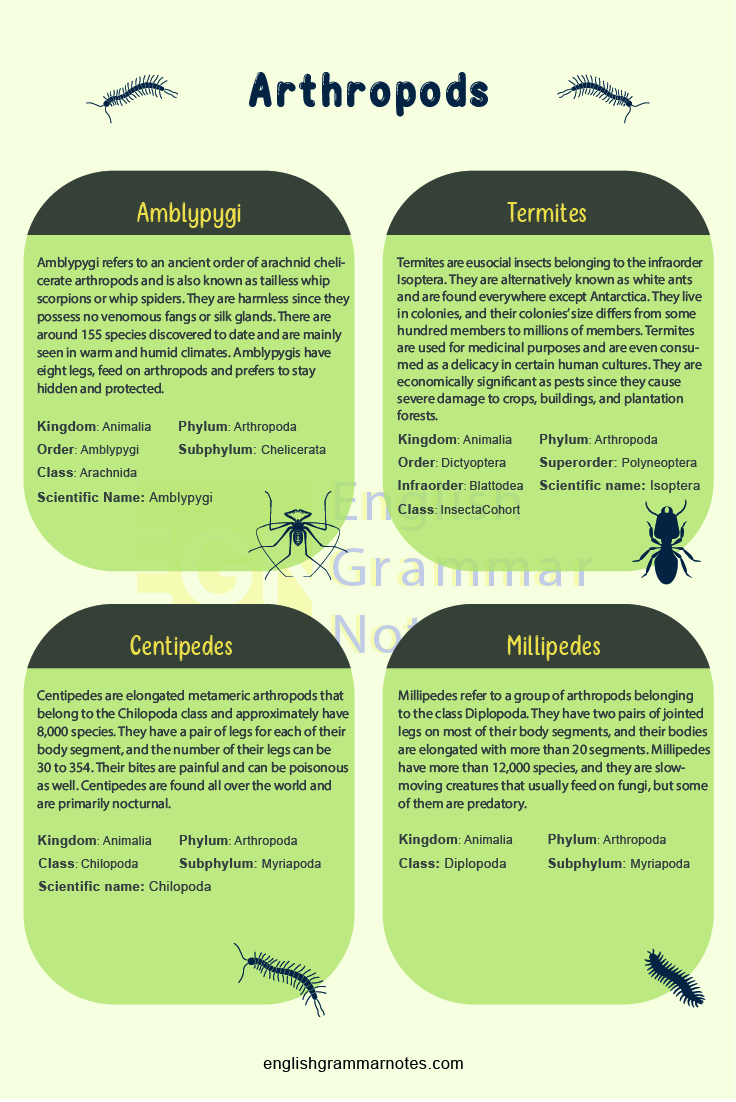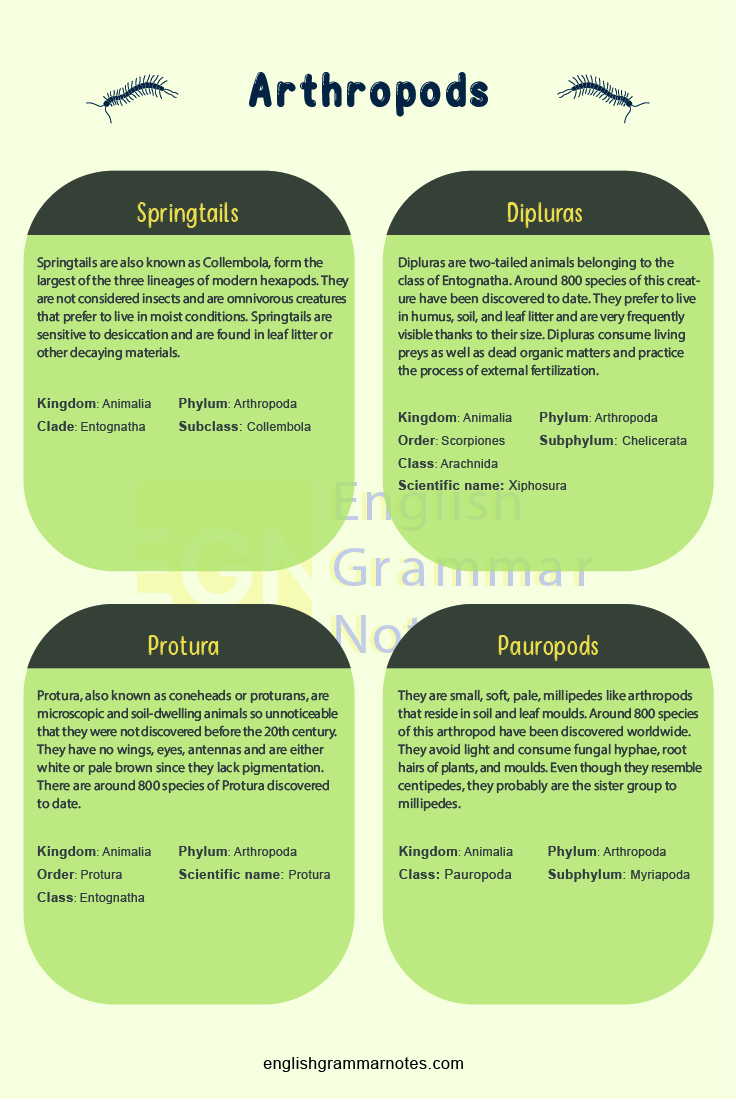Arthropods: There are various types of arthropods present in the kingdom of Animalia. Each of them has very different characteristics, and even though some of them resemble each other, most of them look very different and unique. Arthropod refers to the Phylum of Arthropoda, which constitutes various invertebrate animals like spiders, crustaceans, prawns.
There are groups of arthropods that include terrestrial arthropods and marine arthropods. In this article, we have sorted together a list of arthropods along with their scientific classifications. There are hexapods, chelicerate arthropods, crustaceans, and many more.
Study the most important English Vocabulary Words identified by our experts and learn the right vocabulary to use in your day to day conversations
This list contains classes of arthropods and characteristics along with proper pictures that will help one to gain excess knowledge about these unique creatures and also identify these creatures precisely.
List of Arthropods
Name of Arthropods
- Chelicerates
- Arachnids
- Xiphosura
- Pycnogonida
- Scorpiones
- Amblypygi
- Crustaceans
- Crab
- Crayfish
- Krill
- Lobster
- Prawn
- Hexapods
- Springtail
- Insects
- Flea
- Protura
- Termite
- Myriapods
- Centipedes
- Millipedes
- Pseudocentipedes
- Pauropods
- Trilobites
- Agnostida
- Redlichiida
- Corynexochida
- Odontopleurida
- Lichida
- Phacopida
Description of the arthropods given on the list
Chelicerates
Arachnids refer to a class of joint-legged invertebrates that includes mites, spiders, ticks, scorpions, harvestmen, and solifuges. They have eight legs and are terrestrial animals residing on the land.
Arachnids are carnivorous and, they produce a digestive juice inside their stomach that they pour over their dead prey. There are around 100,000 species of arachnids.
| Kingdom | Animalia |
| Phylum | Arthropoda |
| Subphylum | Chelicerata |
| Class | Arachnida |
| Scientific name | Arachnida |
Xiphosura is an order of arthropods that are related to arachnids. They are also known as horseshoe crabs, and, currently, only four species of this arthropod have been discovered. They have four eyes and, their entire body is covered with a strong cuticle. Their circulatory systems are very well-developed.
| Kingdom | Animalia |
| Phylum | Arthropoda |
| Subphylum | Chelicerata |
| Clade | Prosomapoda |
| Order | Xiphosura |
| Scientific name | Xiphosura |
They are predatory arachnids that belong to the class of Scorpiones. These have long legs, narrow and segmented tails, and 2,500 described species. Scorpions chiefly live in deserts but can be found on every continent except the continent of Antarctica. They have venomous and powerful stings and consume insects and invertebrates.
| Kingdom | Animalia |
| Phylum | Arthropoda |
| Subphylum | Chelicerata |
| Class | Arachnida |
| Order | Scorpiones |
| Scientific name | Scorpiones |
Sea spiders are known as Pycnogonidas since they belong to the class of Pycnogonida. These are aquatic arthropods that have long legs and small bodies. Around 1,300 species of this arthropod are discovered to date and are found in many parts of the world. They are carnivorous and consume sponges, bryozoans, cnidarians, and polychaetes.
| Kingdom | Animalia |
| Phylum | Arthropoda |
| Subphylum | Chelicerata |
| Class | Pycnogonida |
| Order | Pantopoda |
| Scientific name | Pantopoda |
Amblypygi refers to an ancient order of arachnid chelicerate arthropods and is also known as tailless whip scorpions or whip spiders. They are harmless since they possess no venomous fangs or silk glands.
There are around 155 species discovered to date and are mainly seen in warm and humid climates. Amblypygis have eight legs, feed on arthropods and prefers to stay hidden and protected.
| Kingdom | Animalia |
| Phylum | Arthropoda |
| Subphylum | Chelicerata |
| Class | Arachnida |
| Order | Amblypygi |
| Scientific name | Amblypygi |
Crustaceans
Crabs are decapod crustaceans belonging to the order of Brachyura. They are found in all the world’s freshwater oceans and land. They have a thick exoskeleton and are seen walking sideways because of their legs. Crabs are consumed worldwide, and there are many different cuisines prepared with them.
| Kingdom | Animalia |
| Phylum | Arthropoda |
| Subphylum | Crustacea |
| Class | Malacostraca |
| Order | Decapoda |
| Suborder | Pleocyemata |
| (unranked) | Reptantia |
| Infraorder | Brachyura |

Crayfish, also known as freshwater lobsters, yabbies, crawdaddies, mudbugs, and crawdads, is a freshwater crustacean related to small lobsters and resembles them a lot. They have feather-like gills and are unable to tolerate polluted water.
They feed on both plants and animals. Crayfish is a Swedish cuisine, and only a part of it is edible and consumed worldwide.
| Kingdom | Animalia |
| Phylum | Arthropoda |
| Subphylum | Crustacea |
| Class | Malacostraca |
| Order | Decapoda |
| Suborder | Pleocyemata |
| Infraorder | Astacidea |
| Scientific name | Cambarus sp. |
Krill are small crustaceans belonging to the order of Euphausiacea that are found worldwide in all the oceans. Most of them are filter feeders who filter their food with the help of their front-most appendages. Krill can be both omnivorous and carnivorous, and they have been harvested as a source of food for humans and domestic animals since the 19th century.
| Kingdom | Animalia |
| Phylum | Arthropoda |
| Subphylum | Crustacea |
| Class | Malacostraca |
| Superorder | Eucarida |
| Order | Euphausiacea |
Lobsters refer to the family of large marine crustaceans that live in caves and crevices of the ocean floor. They have long bodies, muscular tails, and five pairs of legs, out of which three teams have claws. The lobsters are extremely popular as seafood items and are very profitable for the coastal regions.
| Kingdom | Animalia |
| Phylum | Arthropoda |
| Subphylum | Crustacea |
| Class | Malacostraca |
| Order | Decapoda |
| Superfamily | Nephropoidea |
| Family | Nephropidae |
Prawn is a name used to refer to small marine crustaceans with ten legs and an exoskeleton. The term originated in Britain and is used primarily in Ireland, United Kingdom, and commonwealth nations. In North America, the time Prawn is not used very frequently and is typically used for referring to freshwater shrimps.
| Kingdom | Animalia |
| Phylum | Arthropoda |
| Class | Malacostraca |
| Order | Decapods |
| Family | Dendrobranchiata |
| Scientific name | Dendrobranchiata |
Hexapods
Springtails are also known as Collembola, form the largest of the three lineages of modern hexapods. They are not considered insects and are omnivorous creatures that prefer to live in moist conditions. Springtails are sensitive to desiccation and are found in leaf litter or other decaying materials.
| Kingdom | Animalia |
| Phylum | Arthropoda |
| Class | Entognatha |
| Subclass | Collembola |
Dipluras are two-tailed animals belonging to the class of Entognatha. Around 800 species of this creature have been discovered to date. They prefer to live in humus, soil, and leaf litter and are very frequently visible thanks to their size. Dipluras consume living preys as well as dead organic matters and practice the process of external fertilization.
| Kingdom | Animalia |
| Phylum | Arthropoda |
| Class | Entognatha |
| Order | Diplura |
| Scientific name | Diplura |
Flea is the name given to the order Siphonaptera, which incorporates around 2,500 species of wingless insects that exist as external hosts and consume blood or hematophagy of their hosts. They are quick, brown coloured insects that have long legs and are good at jumping.
| Kingdom | Animalia |
| Phylum | Arthropoda |
| Class | Insecta |
| (unranked) | Eumetabola |
| (unranked) | Endopterygota |
| Superorder | Panorpida |
| Order | Siphonaptera |
| Scientific name | Siphonaptera |

Protura, also known as coneheads or proturans, are microscopic and soil-dwelling animals so unnoticeable that they were not discovered before the 20th century. They have no wings, eyes, antennas and are either white or pale brown since they lack pigmentation. There are around 800 species of Protura discovered to date.
| Kingdom | Animalia |
| Phylum | Arthropoda |
| Class | Entognatha |
| Order | Protura |
| Scientific name | Protura |
Termites are eusocial insects belonging to the infraorder Isoptera. They are alternatively known as white ants and are found everywhere except Antarctica. They live in colonies, and their colonies’ size differs from some hundred members to millions of members.
Termites are used for medicinal purposes and are even consumed as a delicacy in certain human cultures. They are economically significant as pests since they cause severe damage to crops, buildings, and plantation forests.
| Kingdom | Animalia |
| Phylum | Arthropoda |
| Class | InsectaCohort |
| Polyneoptera | Superorder |
| Dictyoptera | Order |
| Blattodea | Infraorder |
| Isoptera | Scientific name |
| Isoptera |
Myriapods
Centipedes are elongated metameric arthropods that belong to the Chilopoda class and approximately have 8,000 species. They have a pair of legs for each of their body segment, and the number of their legs can be 30 to 354.
Their bites are painful and can be poisonous as well. Centipedes are found all over the world and are primarily nocturnal.
| Kingdom | Animalia |
| Phylum | Arthropoda |
| Subphylum | Myriapoda |
| Class | Chilopoda |
| Scientific name | Chilopoda |
Millipedes refer to a group of arthropods belonging to the class Diplopoda. They have two pairs of jointed legs on most of their body segments, and their bodies are elongated with more than 20 segments. Millipedes have more than 12,000 species, and they are slow-moving creatures that usually feed on fungi, but some of them are predatory.
| Kingdom | Animalia |
| Phylum | Arthropoda |
| Subphylum | Myriapoda |
| Class | Diplopoda |

Symphylans, commonly known as pseudocentipedes or garden centipedes, are soil-dwelling arthropods belonging to the Symphyla class. They are distantly related to millipedes and centipedes and are fast-moving creatures.
These arthropods are small and non-venomous, and they feed on decaying vegetation but also cause damage in agricultural settings. Worldwide, only 200 species of this arthropod are known.
| Kingdom | Animalia |
| Phylum | Arthropoda |
| Subphylum | Myriapoda |
| Class | Symphyla |
They are small, soft, pale, millipedes like arthropods that reside in soil and leaf moulds. Around 800 species of this arthropod have been discovered worldwide. They avoid light and consume fungal hyphae, root hairs of plants, and moulds. Even though they resemble centipedes, they probably are the sister group to millipedes.
| Kingdom | Animalia |
| Phylum | Arthropoda |
| Subphylum | Myriapoda |
| Class | Pauropoda |

Trilobites
Agnostida is an order of arthropods that first developed during the end of the period of Early Cambrian and thrived during the period Middle Cambrian. According to scientists, they do not have eyes, and according to scientists, they followed either a benthic or an aquatic lifestyle.
Agnostidas most probably lived on the ocean floor and consumed detritus. In the Late Odrovician period, they went extinct.
| Kingdom | Animalia |
| Phylum | Arthropoda |
| Class | †Trilobita |
| Order | †Agnostida |
| Scientific name | Agnostida |
Redlichiida is an order of trilobites and refers to a group of marine arthropods that are now extinct. The first Redlichiida developed in the Lower Cambrian period, while the last died out before the Middle Cambrian ended.
They follow typical Trilobite patterns regarding their legs, gills, numbers, types, antennas, etc. The order Redlichiida is classified into two suborders, the Redlichiina, and the Olenellina.
| Kingdom | Animalia |
| Phylum | Arthropoda |
| Class | †Trilobita |
| Order | †Redlichiida |
| Scientific name | Redlichiida |
Corynexochida
This is an order of trilobite that originated in the Lower Cambrian period and lived till the Late Devonian period. They have many species, and each of them has unique characteristics. The Corynexochida have large eyes and elongated glabella whose sides are usually pestle shaped.
| Kingdom | Animalia |
| Phylum | Arthropoda |
| Class | †Trilobita |
| Order | †Corynexochida |
| Scientific name | Corynexochida |
It is an order of very spinose trilobite and is closely related to the order Lichida. The Odontopleurida order is divided into two families, the Damesellidaeand the Odontopleuridae, and both the families are grouped under the order Lichida. They have bar-shaped cephalons and knob structured glabella. This order lived from the Upper Cambrian period to the Late Devonian period.
| Kingdom | Animalia |
| Phylum | Arthropoda |
| Class | †Trilobita |
| Order | †Odontopleurida |
| Scientific name | Odontopleurida |
Lichida refers to spiny trilobites that developed during the Furongian period and went extinct in the Devonian period. They have 8-13 tapered thoracic segments that are longer than their entire body. The tail is a leaf-like structure that also ends in spines. The order of Lichida is divided into two families, Lichidae, and Lichakephalidae.
| Kingdom | Animalia |
| Phylum | Arthropoda |
| Class | †Trilobita |
| Order | †Lichida |
| Scientific name | Lichids |
Phacopida is an order of trilobite that first developed during the Late Cambrian period and died during Late Devonian. They refer to a morphologically diverse group of associated suborders.
There is still doubt regarding their exact origin, but they are classified into three suborders, Phacopina, Calymenina, Cheirurina. They have 8-19 thoracic segments and schizochoral eyes that comprises around 700 lenses.
| Kingdom | Animalia |
| Phylum | Arthropoda |
| Class | †Trilobita |
| Order | †Phacopida |
| Scientific name | Phacopida |